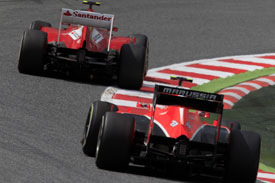Marussia has confirmed it will use Ferrari engines when the new 1.6-litre V6 turbocharged power units are introduced at the start of next season.
The deal is part of a wider technical partnership, which includes the team being supplied with gearboxes and related systems.
Team CEO Andy Webb stressed the significance of the deal for the team's long-term future.
"The importance of this development to our team cannot be overstated," said Webb.
"Not only will we benefit from a customer supply from the most successful engine manufacturer in F1's history, but this also provides further confirmation, if it were needed, of our commitment to the sport and determination to maintain our progression towards our long-term ambitions.
"The new powertrain regulations being introduced next year represent the most substantial engine development within the sport since the introduction of the V8 formula and are all the more significant for the increased contribution of the energy recovery system.
"We look forward to working with Scuderia Ferrari during this exciting new era of F1 competition."
Marussia has used Cosworth engines since joining the F1 grid at the start of the 2010 season.
Webb paid tribute to the work done by the British engine manufacturer over the past four seasons.
"We would also like to take this opportunity to thank Cosworth, with whom we have partnered since our debut season in 2010," he said. "We have shared an important part of our team's journey together and Cosworth have been an integral part of our clear progression.
"We have shared an important part of our team's journey together and Cosworth have been an integral part of our clear progression.
"We will continue to work together during the latter half of the season to ensure we all achieve our combined objectives before Cosworth leave the sport."
Despite this new technical partnership with Ferrari, Marussia will continue to have a similar deal with McLaren.
The McLaren technical partnership involves the use of aerodynamic facilities such as the windtunnel, so will not conflict with the Ferrari powertrain deal.
SOURCE: Autosport
ED: The team is also parting ways with Pat Symonds with immediate effect.
Log in to comment